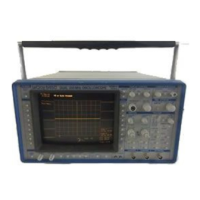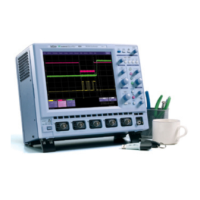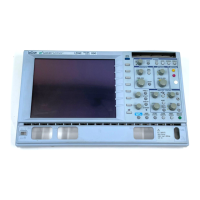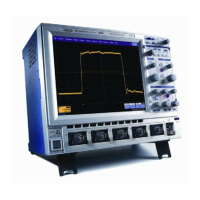This is a useful feature for very low repetition rate signals acquired
in the NORMAL trigger mode. Subsequent display of the selected
reference memory provides the user with a lasting waveform display
which can be studied long after the originally acquired signal has been
erased. In the NORMAL trigger mode the CHAN 1 and CHAN 2 displays are
automatically erased after a two second interval to warn the user that
a proper trigger is not available.
5.2.5.2 Common Expand Mode
Section 5.1.4 discusses independent expansion of single traces to
display a magnified portion of the waveform from CHAN 1 and/or CHAN 2,
Memories C and/or D, or of Function E and/or F if the 9400A is equipped
with WPOI Waveform Processing firmware. However, in certain
applications, it is convenient to be able to move the intensified
region along two different traces simultaneously. This is the purpose
of the Common Expand mode.
In this mode it is possible to either synchronize the intensified
regions of the two source signals, or to maintain a fixed time interval
between them, in which case the intensified regions for each trace will
move horizontally at a fixed interval. (See Section 8.11 for an example
of intensified regions shifting on two traces expanded in the Common
Expand mode).
In the Common Expand mode, when the user is examining two expansions at
a fixed interval (he may re-synchronize them by pressing the RESET
button (41)) both expansions are shifted to the center of the grid.
Turning the Horizontal POSITION control (39) until both of the
intensified regions move off the screen will also re-synchronize them.
In the Common Expand mode, only the Horizontal POSITION control (39)
and TIME MAGNIFIER control (43) act simultaneously on the intensified
regions on both the EXPAND A and B signal source, while the VERT GAIN
control (42) and Vertical POSITION control (40) act independently
each expanded waveform.
Note that when the Common Expand mode is called,
the EXPAND A
magnification factor applies to both A and B expansion.
5.2.6 RS-232-C Setup (8)
Two RS-232-C ports are available on the rear panel of the 9400A
permitting remote oscilloscope operation and data transfer, as well as
convenient plotter interfacing.
5-26
Manual Operation

